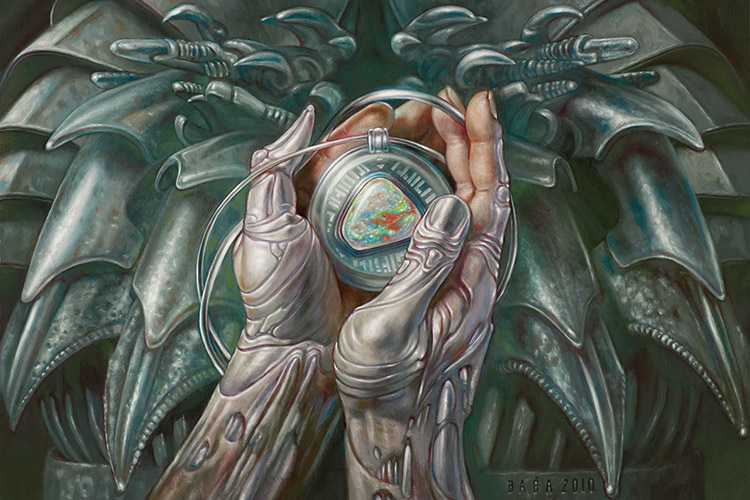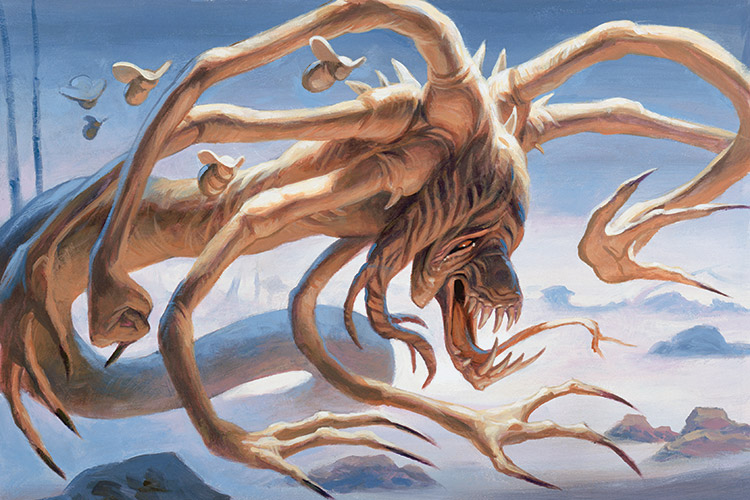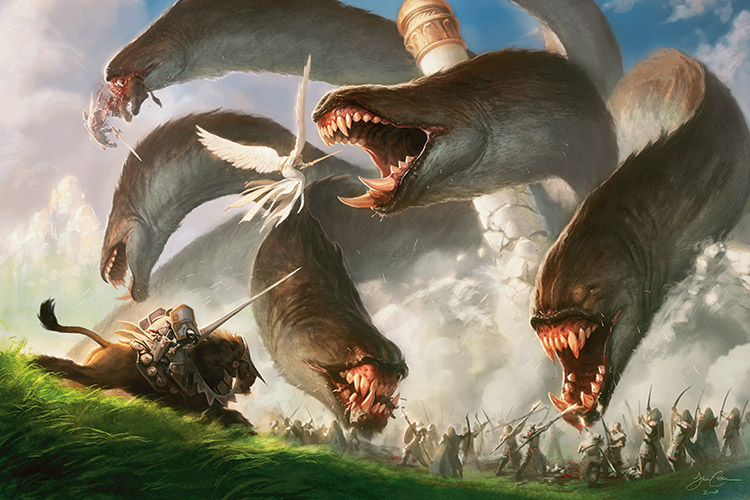Color Pair Building Blocks
It's Modern Week here on DailyMTG.com, but as you may have predicted, we will not be debating the banning of Birthing Pod nor the impact of Collected Company on the current metagame. No, this column is dedicated to the tried and true Limited player. It takes a special breed to love Limited as much as we do. You have to love deck building, mana bases, variance, making plans, opening booster packs, and playing games—all under the watchful eye of a clock.
We may be eschewing the Modern discussion this week in favor of something more forty-card-oriented, but we won't be traveling too far. After all, part of what makes this set special is that we'll be able to draft these amazing cards. For the first time, for a lot of us. This week I'd like to take a look at the ten color-pairs and how they are generally represented in Limited. To pay homage to Modern Week, we'll also highlight a few of the color pairs that caught my eye from Modern Masters 2015 Edition.

Mox Opal | Art by Volkan Baga
Archeytpical
When considering a brand new format, it's useful to think in terms of archetypes. An archetype is a typical example of a certain thing. In this case, how two-color combinations work together in Limited Magic.
Most sets are designed such that you will be playing two-color decks in Limited. The times when they aren't tend to stand out, as was the case in Khans of Tarkir. But for the most part you should expect new Limited sets to be two colors with some amount of mana fixing to enable potential splashes.
If that's the case, then there should be ten two-color combinations that we'll see over and over in Limited. Getting a grasp on what each of these does historically can help you prepare for a new set. I want to note here that we are speaking in generalities. Most sets offer exceptions to these two-color pairs and how they function. New mechanics and set structures can mess with this as well. Sometimes we see the color pairs expressed in a way you wouldn't expect.
Let's dive into these in an attempt to set a blueprint for what these color pairs do from a set-to-set perspective. As mentioned, I'll also be including some Modern Masters 2015 Edition predictions in a few of the ones that caught my eye.
White-Blue
When most people think of white and blue for Limited, they think of the "flyers" deck. This is a deck that uses flying creatures from both white and blue (these two colors get the most flying creatures) to win in the air. It also uses high-toughness blockers on the ground in combination with blue tempo spells and reactive white removal to slow down the opponent long enough to get the job done in the air.
When this archetype is good, it tends to be very good. Flying is just so strong in Limited.
In Modern Masters 2015 Edition, it seems to have a strong artifact sub-theme, as well as touches on the Spirits deck we talked about in our preview column for the set (though that deck is white-black).
There are plenty of good artifacts in the set to help this archetype along.
Blue-Red
Blue and red tend to not make a great pair, to be honest. One thing we'll see from these color pairs is that the amount and quality of removal dictates a lot of what these decks can do. Blue gets some tempo spells and soft removal (removal that doesn't actually kill the creature), and red gets burn spells. Burn spells are traditionally good at killing small- and medium-sized creatures, but can have a hard time with big, bomby, threats.
When this archetype does come together, it's usually because a certain mechanic enables it. The decks are tempo based, and quick. They involve haste creatures, flyers, and cheap, interactive spells. They usually don't play defense very well, so they trend toward the assertive end of the spectrum.
Green-Blue
Green and blue is probably my favorite two-color combo in Magic. It offers a very attractive one-two punch of big creatures and powerful tempo plays. You also get to draw a bunch of cards, which is kind of the best thing ever. I mentioned removal before, and that is the Achilles heel of this deck: it doesn't really have any actual removal. These days, green gets a bunch of "fight" cards, which do a good job of approximating removal. The blue bounce spells and soft removal are still here too.
This is one of the more interesting combos for Modern Masters 2015 Edition, with proliferate and graft combining to make some pretty cool interactions.
Basically, graft creatures are made up of +1/+1 counters and proliferate cards let you add counters to all of them at once. If you can get a bunch of graft creatures onto the battlefield and then start a proliferate engine, your team will grow out of control quickly.
Blue-Black
Ah yes, my other favorite two-color combo. Blue and black tend to combine to make up the most value-iest of combos. In most formats, this pair is a control deck, with solid black removal and blue card-drawing overpowering traditional decks through card advantage. A nice, big bomb or even just a few blue flyers can finish the job once the dust has settled.
These decks tend to be slow, however, and susceptible to being run over by a quick draw from a good aggressive deck. In my mind, you build the deck with that matchup in mind and take your lumps otherwise. If removing threats and drawing cards is your game, you've found your home. Welcome.
Black-Red
We have arrived at our first truly aggressive color combination. Black usually gets a nice assortment of cheap threats and top-tier removal, while red gets even more cheap threats and efficient early-game burn spells that can help finish off the opponent in the late game. If it just drives you nuts that your opponent gets to start the game at 20 life and you want to remedy that as quickly as possible, this is your deck.
For Modern Masters 2015 Edition, we see the return of the bloodthirst mechanic! Beatdown players rejoice, as bloodthirst is great at not only killing the opponent, but also encouraging you to play the most aggressive deck possible. It's all beatdown, all the time.
Normally, a card like Goblin Fireslinger wouldn't be too high on anyone's list, but when it enables the bloodthirst on incredible curveout cards like Blood Ogre, it goes up considerably.
Black-Green
Black-green is one of the more "grindy" color pairs. We say grindy when we want to describe a deck that tends to pick up small advantages over the long term. These decks are usually slanted toward the middle of the aggressive/control spectrum, and they tend to play solid creatures and spells at most mana costs.
If most Limited decks are midrange in nature, these are the midrangiest. You get the green creatures, you get the black removal spells, and you get to clog up the board and eventually push through damage with your big green monsters. The deck can also take a more proactive role against slow decks, given the right draw.
White-black
White-black is probably the color pair that is toughest to nail down as an archetype. Generally, it has access to some of the best removal available, but the creatures don't usually mesh very well. White gives you a bunch of small creatures and maybe some tokens. Black gives you a range of creatures, but rarely do you get the big hitters you'd like to see in a removal-heavy pair like this. You can assume your removal will be good, so the question focuses on how good the creatures are at capitalizing on this.

Thief of Hope | Art by Greg Hildebrandt
Often, it comes down to the mechanics specific to the set, and if they offer much synergy between the colors. In Modern Masters 2015 Edition, we see a great example of when the answer to this question is "yes!" We see Spirits.
We previewed these guys a few weeks ago in this column, and they still stand as one of the best reasons to go white-black in this set. You get the Spirits and Arcane action going and it's a powerful strategy that offers great late-game inevitability while keeping you alive long enough to get there.
Green-White
This pair is often considered the "fairest" of the color combos. It tends to have reasonable creatures at all relevant mana costs and is a popular choice for newer players since its game plan is so straightforward. It plays creatures, backs them up with combat tricks and a little removal, and tries to get its beatdown on. The quality of the white removal and the green fight cards can be the difference maker for this kind of deck.
The reason not to play this kind of deck is if other decks offering more synergy are outpacing it. You just don't get to interact a lot with the opponent or with your own cards, so your power level and consistency have to make up for it. That's a tall order, but does come together sometimes.
Red-White
This pair is skewed heavily toward the aggressive end of things, but with a cool twist. The cards lend themselves to focusing on the two- and three-drop slots, as many of the best creatures will be there as well as the good removal spells. That means that you can start putting reasonable threats on the table and back them up with tricks and removal. You get cheap burn spells, powerful white removal, and a bunch of combat tricks to keep the damage flowing.
The really cool part of this combo is the ability to make tokens. Both colors have the ability to make tokens and you can "go wide" and use mass-pump spells to power through tons of damage.
In Modern Masters 2015 Edition, we see less of a token theme and more of a creature augmentation theme.
With creatures like this in the mix, you can see how powerful it is to pump them up in any way. Equipment, Auras, temporary pump spells, whatever. Just make that power go up a few times and the game should end shortly thereafter.
Red-Green
Most people think of ramp when they see these colors, and that's somewhat true in Limited as well. I wouldn't say it's the primary strategy however. No, this deck ends up being more of a "dinosaurs" deck more often than not. You know, the kind of deck that just puts big, dumb creatures on the battlefield and attacks with them. I know it sounds a little pedestrian, but this strategy is surprisingly good in many formats.
A good example is versus the white-blue deck we talked about earlier. If you just make big threats that can power through the ground blockers and outrace the flyers, it puts a lot of pressure on the opponent to have specific answers to your threats right away. To be fair to the example, if they do have those answers, you usually just lose. There is a downside to just playing big creatures without much in the way of synergy.
I don't have much to add for the archetype in Modern Masters 2015 Edition other than to point out that one of the sweetest creatures with the sweetest artwork is getting reprinted here, Apocalypse Hydra:

Apocalypse Hydra | Art by Jason Chan
Takeaways
As always, my hope with the column is that you'll learn something that helps you improve your game. There is a lot to love about this passion of ours, but I think my favorite thing is the opportunity it gives us to constantly improve. It feels like the ceiling is so high in this game that you could just keep working on your game forever, and I find comfort in that.
Knowing what the two-color combos do in a general sense can set the stage for how a set breaks down, but it's more of a baseline that you can use to differentiate when the pairs diverge from the norm. When I played basketball in high school, my coach would always tell us that we had to learn the fundamentals of the game before we could get all fancy like the professional players we idolized.
He was totally right, too. The more I focused on the basics, the more easily the fancy stuff came to me. Magic is the same. If you know what the color pairs do normally, you'll know when it's special that they do something else. And that can mean the difference between being significantly ahead of the curve and lagging behind with the rest of the crowd.
I'll take the former.
Until next week!
